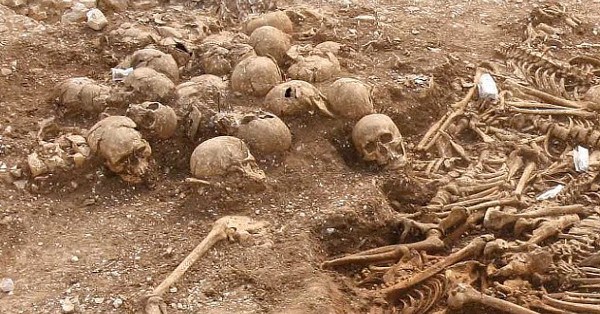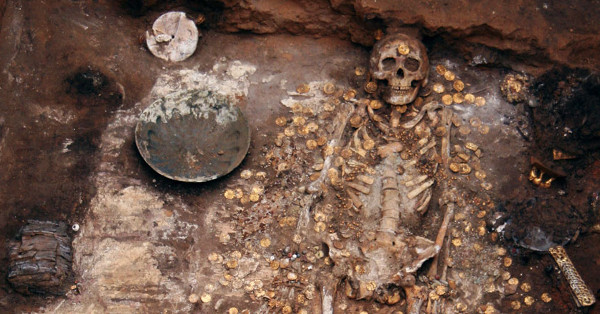Perhaps found the tomb of Genghis Khan
 Mongolian archaeologists reported the accidental discovery of the tomb of Genghis Khan. It is not known for certain where the first great Khan is buried. There are many versions of where his grave is located and with some periodicity there were reports of the discovery of his tomb. This time the find looks very convincing.
Mongolian archaeologists reported the accidental discovery of the tomb of Genghis Khan. It is not known for certain where the first great Khan is buried. There are many versions of where his grave is located and with some periodicity there were reports of the discovery of his tomb. This time the find looks very convincing.Almost 800 years is unknown where the great Khan was buried. Even about the circumstances of his death, little is known. It is a popular story that the founder of the Mongolian Empire asked to be buried in a nameless secret tomb. In order not to demoralize the soldiers of the Horde, according to his will, the death of Genghis Khan was announced only after the final victory over the Tanguts . About the death of Khan knew only the closest relatives, who organized a secret funeral.
It is known that Genghis Khan wanted to be buried near the river Onon, - there he was born and grew up, there he was proclaimed ruler of the united people. Genghis Khan died in August 1227 in the mountains of Lupan. His body was transported back to Mongolia for burial. According to both Marco Polo and Rashid ad-Din, the funeral escort killed everyone he met along the way. Genghis Khan wanted to be buried with a multitude of rich objects, sacrificial horses and, possibly, people. One of the texts says that 40 girls — adorned with rich robes, gold, and small precious stones — were killed and buried with him to join his spirit in the afterlife.

The search for the tomb of Genghis Khan has been going on for a long time. The most promising place to search is the forbidden mountain Burkhan-Khaldun and its surroundings, where, according to historical records, was the ancestral necropolis of the Tamuzhin family. The mountain is listed as a UNESCO World Heritage Site and any excavations in its surroundings are unlikely in the near future. Shamanistic beliefs still play an important role in the daily life of the Mongol nomads. They believe that their ancestors are alive in sacred places, and disturbing the graves is unthinkable.
Another popular version is the tomb of Genghis Khan located at the bottom of the Selenga River . After his death, the sons of the emperor drove into the valley of the river thousands of slaves who built a dam and changed the course of the waters. In the drained rocky bottom, a niche was hollowed out, where the coffin with the body of the Great Khan was placed, after which, under cover of night, the dam was destroyed and everyone who was in the valley - slaves, masons, guards and soldiers of the guard of honor, drowned.
')
Those who miraculously survived fell under the swords of a special detachment, which, in turn, was also destroyed. Thus, no one was left alive to tell where Genghis Khan had found the last refuge.
To the grave did not find the random travelers, along the banks of the Selenga repeatedly drove herds of horses. Having buried his father, the emperor's heirs conducted burial rites in eight more places, and the secret of the tomb of Genghis Khan died with his sons, who never again spoke on this subject.

During the construction of the road near the Onon River to the Khentiy aimak in Mongolia, road workers discovered a mass grave with a multitude of human remains, under which there was a rather coarse-built stone structure.
Forensic scientists and archaeologists have identified the burial as a 13th century Mongol royal tomb, which may belong to Genghis Khan. Scientists at the University of Beijing concluded that the numerous skeletons (68 skeletons) buried over the tomb most likely were slaves who built the tomb and were killed in order to keep its location secret. Also, 12 horses were sacrificed to accompany the great khan after death.
The contents of the tomb are very scattered and in a deplorable state - for several centuries this area was under the river bed until the Onon river changed the direction of the channel in the 18th century. The tomb contains the remains of a tall man and 16 female skeletons among hundreds of gold and silver objects and thousands of coins. The women were supposed to have been the khan's wives and concubines who were killed to accompany the commander in the afterlife.

The number of treasures and the number of animals and people killed, immediately raised before archaeologists the question that this is certainly the burial place of a truly important Mongolian commander. After conducting an extensive set of tests and analyzes, they were able to assert that the body belonged to a man between the ages of 60 and 75 who died between 1215 and 1235 AD. And the age, date, place and pomp of the burial, with high probability, confirm that the tomb really belongs to Genghis Khan.
The historical significance of Genghis Khan makes this new discovery one of the most important in the history of archeology and puts an end to one of the mysteries of history. His legacy in many forms besides its conquest can still be found today, which makes it one of the most influential people in the history of mankind. He connected the East and the West by creating the Great Silk Road, which became and remained for many centuries the main network of trade and transfer of cultural values in Eurasia, opening political and economic interactions between distant civilizations.
Genghis Khan also has an incredible number of descendants. Some genetic studies state that he may be the direct ancestor of every two hundredth of living people. Only in Mongolia, out of a population of 2 million, 200,000 may be its descendants.
PS Regarding the tomb there is a refutation of asiarussia.ru/news/4903
Regarding the origin of the photo - in the comments .
More accurate info could not be found.
Source: https://habr.com/ru/post/396561/
All Articles